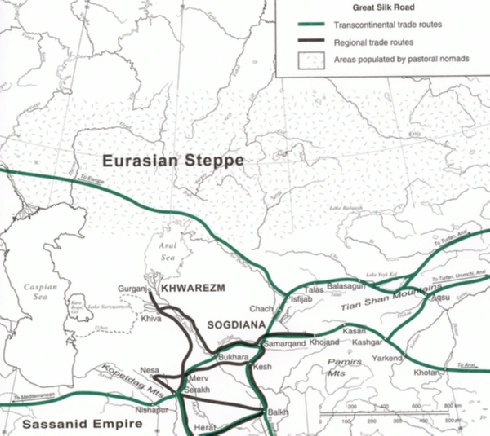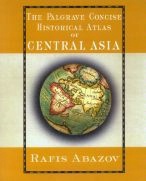Map 13: International Trade and the Beginning of the Great Silk Road
The growth in trade was stimulated by innovative developments in transportation and finance. By the sixth century B.C. the local people had greatly improved their transportation capacity as caravans increased in size. The selective breeding process helped to adapt domestic animals-Bactrian camels, horses and bulls-for carrying goods longer distances, and improvements in transportation technology helped to establish and expand the trade routes. At the same time, local rulers established more or less clear norms for issuing their currencies, while local dealers developed a rudimentary international currency market.
These changes in turn facilitated the establishment of a commercial-scale transportation and trade infrastructure for the era's local, regional and international trade. Of course, the economic, political and legal changes and technological advances also contributed to the rise of this trade. Tradable items included highly prized nephrite jade and race and cavalry horses that were exported to China, and silk, porcelain and many other exotic goods sent from China to Central Asia, Persia, the Roman Empire and the rest of the Mediterranean and Egypt. High-quality weapons were traded in all directions.
Regional and international trade became increasingly profitable, supported by the growth of wholesale stores at the bazaars. With the rise of the trade capitals, and consequently the rise of the trading missions (caravans), there was serious demand for caravanserais, inns, that provided safe accommodation for travelers. From the early days merchants also nurtured positive relations with and patronage from local rulers by frequently supplying exotic and luxury gifts. This gift-giving tradition gradually evolved into regular and more-or-less clearly defined taxes. In the end, the local rulers found they had substantial motive to provide legal, military and financial guaranties to the merchants.
Some ancient rulers went even further by establishing, protecting and operating strategically important highways. One such road was known as the Persian Royal Road. It was probably established in the fifth century B.C., and it stretched 2,000 miles (about 3,200 kilometers), connecting Persian-controlled seaports on the eastem Mediterranean with trading and political centers on the Tigris River. This road was serviced by caravanserais, postal stations and small military garrisons. Similar but probably less sophisticated roads connected Persia with the ancient cities of Merv, Bukhara, Samarqand, Herat and other centers.
Eventually the many fragmented trade routes expanded far enough to connect the major trading centers in China, Central Asia, Persia, Mesopotamia and the Mediterranean. Many scholars date the beginning of the Great Silk Road to the second century B.C. During this period the rulers of the Han Dynasty (ca. 206 B.C.-220 A.D.) discovered commercially viable routes to Central Asia, Persia and Europe.
Geographical and climatic considerations imposed significant limitations on the direction of the trade routes. The high and inhospitable mountains of the Tian Shan, Pamirs and Himalayas created serious obstacles for trade between the richest and most advanced ancient civilizations of China, IPersia and the Mediterranean.
Ancient travelers had two choices. One was to go through the passes in the Tian-Shan and the Pamirs Mountains: Anxi, Khotan, Yarkend, Kashgar, Balkh and Merv, and then to Persia and the Mediterranean. The other was to travel through the broad stretches of grassland to the north of the mountain slopes: Anxi, Turfan, Urumchi, Balasagun, Chach (Tashkent), Samarqand, Bukhara, Merv and on, once again, to Persia and the Mediterranean. Of course, at different times varying circumstances could cause the routes to deviate significantly.
The Silk Road developed its own business cycles, as it was greatly affected by the political, military and economic development in all regions along its length: in China, in the principalities of Central Asia, the nomadic states and empires of the Eurasian Steppe, in Persia and the Mediterranean world. Large-scale trade flourished along the transcontinental Silk Road for about 400 years until its collapse in the early second century A.D. due to the disintegration of both the Han Empire in China and the Parthian Empire in Central Asia, and the beginning of the "great population movement" in the steppe zone between Mongolia and the Black Sea. The Silk Road was reinvented between the seventh and tenth centuries A.D. under the Tang Dynasty (618-907 A.D.) and again between the thirteenth and fifteenth centuries (under the protection of the Mongol Empire).
(ibid., Map 13: International Trade and the Beginning of the Great Silk Road)


